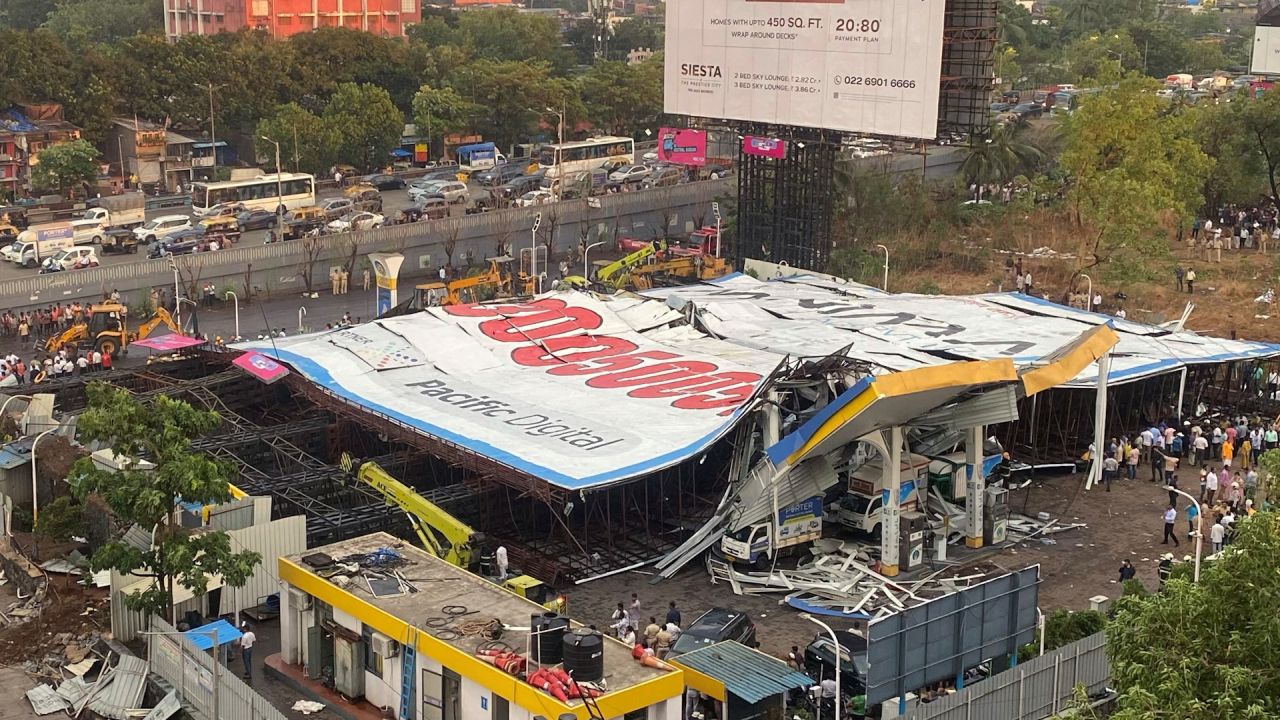
A recent tragedy in the bustling city of Mumbai, India, has highlighted the potential dangers posed by large outdoor billboards during severe weather conditions. A sudden and “freak” storm caused a massive billboard to collapse on a petrol station, claiming the lives of 14 individuals and injuring several others. This incident has brought attention to the risks associated with these sometimes massive structures and underscores the need for enhanced safety measures and regulations surrounding billboards including both the importance of public safety and infrastructure resilience.
The billboard, originally attached to a large building in the Chembur area of Mumbai, succumbed to the force of sudden strong winds and heavy rain. The impact was catastrophic as the billboard collapsed directly onto the gas station below, causing devastation, killing 14, and injuring at least 75. Eyewitness accounts described a scene of chaos and despair, with emergency responders rushing to the site to rescue survivors and attend to the injured.
In response to this incident, local authorities have launched investigations into the circumstances leading to the collapse of the billboard. This includes examining whether proper permits were obtained for the installation of the structure and whether it was in compliance with safety regulations. The goal is to identify lapses in oversight and enforcement and to implement corrective measures to prevent similar tragedies.
Mumbai, like many major urban centers around the world, is dotted with billboards that advertise everything from consumer products to political campaigns. However, the maintenance of these structures often falls short of necessary safety standards. In the wake of this accident, authorities have promised stricter enforcement of existing regulations and a comprehensive audit of all billboards in the city.
The collapse in Mumbai was particularly alarming due to its location in a densely populated area. Eyewitnesses reported that the structure fell without warning, crushing several vehicles and injuring pedestrians. Initial investigations suggest that structural weaknesses, compounded by recent heavy rains, may have contributed to the failure. The incident has led to widespread calls for an immediate review of billboard safety protocols in the city.
The tragedy raises critical questions about the safety standards and oversight surrounding the installation and maintenance of outdoor advertising structures both internationally and domestically. Billboards, especially those situated in densely populated urban areas, can pose significant risks if not properly secured and maintained. Factors such as structural integrity, wind load capacity, and regular inspections are essential considerations to prevent such accidents from occurring in the future, but require consistent attention and demand strict regulations.
The United States is unfortunately no stranger to tragedies surrounding billboards. Earlier this year, two workers in West Virginia were hospitalized after falling from a billboard after a service catwalk broke free. Last year, two more workers in California were injured after their crane tipped over while they were dismantling a billboard. In Georgia, five workers were killed and one injured while servicing billboards in three separate incidents dating back to 2002 when a 35,000-pound sign collapsed on a parking lot.
Several factors have been shown to contribute to the dangers associated with billboards and outdoor advertising:
- Lack of Maintenance: Many billboards are not regularly inspected or maintained, leading to deterioration over time.
- Weather Conditions: Severe weather, including storms and high winds, can compromise the structural integrity of billboards.
- Substandard Construction: In some cases, billboards are constructed without adhering to strict engineering and safety standards.
- Overloading: Adding heavy digital screens or additional signage can overload structures that were not designed to support such weight.
These unfortunate events serve as a sobering reminder of the importance of robust infrastructure standards and stringent safety protocols, particularly in rapidly growing urban environments. As cities and urban areas continue to develop and expand, the need for proactive measures to safeguard public spaces becomes increasingly critical.
After a billboard fell onto a parking lot in a Bronx suburb in 2019, the city of New York enacted legislation in 2023 to ban billboards within 1,500 feet of certain cooperative housing developments. This is one such type of legislation that can help prevent the many negative impacts of billboards and other forms of outdoor advertising.
Scenic America extends its deepest condolences to the families and loved ones affected by this most recent devastating incident. We urge policymakers, city planners, and stakeholders to prioritize public safety in the design and management of outdoor advertising infrastructure and consider policy to mitigate these events through an overall reduction in the number of billboards and outdoor signs. By learning from this tragedy and taking decisive action, we can work towards creating safer, more resilient communities where such accidents are prevented, and lives are protected.